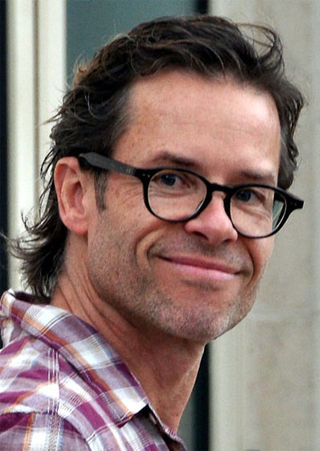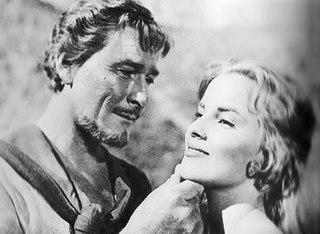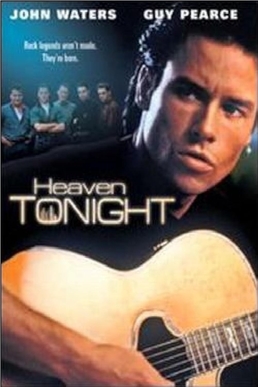Related Research Articles

Errol Leslie Thomson Flynn was an Australian-American actor who achieved worldwide fame during the Golden Age of Hollywood. He was known for his romantic swashbuckler roles, frequent partnerships with Olivia de Havilland, and reputation for his womanising and hedonistic personal life. His most notable roles include Robin Hood in The Adventures of Robin Hood (1938), which was later named by the American Film Institute as the 18th-greatest hero in American film history, the lead role in Captain Blood (1935), Major Geoffrey Vickers in The Charge of the Light Brigade (1936), and the hero in a number of Westerns such as Dodge City (1939), Santa Fe Trail, Virginia City and San Antonio (1945).

Guy Edward Pearce is an Australian actor. He is the recipient of various accolades, including a Primetime Emmy Award as well as a nomination for a Golden Globe Award.

Cuban Rebel Girls or Assault of the Cuban Rebel Girls is a 1959 semi-dramatic documentary B movie, and the final on-screen performance of Errol Flynn. He stars with his underage girlfriend, Beverly Aadland.

Claudia Karvan is an Australian actress and producer. As a child actor, she first appeared in the film Molly (1983) and followed with an adolescent role in High Tide (1987). She portrayed a teacher in The Heartbreak Kid (1993) – the film was spun off into a TV series, Heartbreak High (1994–1999), with her character taken over by Sarah Lambert. Karvan's roles in television series include The Secret Life of Us (2001–2005), Love My Way (2004–2007), Newton's Law (2017) and Halifax: Retribution (2020). She won Best Actress in a Leading Role in a Television Drama at the AFI Awards for her appearance in G.P. (1996). She won two similar AFI Awards for her role in Love My Way and in 2014 for her work in The Time of Our Lives (2013–2014). As a co-producer and co-writer on Love My Way, she won three further AFI Awards for Best Drama Series in 2005, 2006 and 2007. Karvan was inducted into the Australian Film Walk of Fame in 2007 in acknowledgment of her contributions to the Australian film and television industry. From 2010 to 2011, she starred in the drama series Spirited, which she co-created and was executive producer. She appeared as Judy Vickers in Puberty Blues. Karvan has co-produced House of Hancock and Doctor Doctor (2016–2021). In 2021 she co-created, co-produced and starred in the TV drama series, Bump.

Too Much, Too Soon is a 1958 American biographical film about Diana Barrymore produced by Warner Bros. It was directed by Art Napoleon and produced by Henry Blanke from a screenplay by Art Napoleon and Jo Napoleon, based on the autobiography by Diana Barrymore and Gerold Frank. The music score was by Ernest Gold and the cinematography by both Nicholas Musuraca and Carl E. Guthrie. Diana died in 1960, two years after the release of the film.

Against All Flags is a 1952 American pirate film directed by George Sherman, with uncredited assist from Douglas Sirk. It features Errol Flynn as Lt. Brian Hawke, Maureen O'Hara as Prudence "Spitfire" Stevens, and Anthony Quinn as Roc Brasiliano. The film is set in 1700, on the coast of Madagascar.

San Antonio is a 1945 American Western film starring Errol Flynn and Alexis Smith. The film was written by W. R. Burnett and Alan Le May and directed in Technicolor by David Butler as well as uncredited Robert Florey and Raoul Walsh.
Frank Michael Howson was an Australian theatre and film director, screenwriter, and singer. He directed Flynn (1996) on the early life of Errol Flynn and Hunting (1991). Howson, with Peter Boyle, helped establish Boulevard Films which produced thirteen films from Boulevard of Broken Dreams (1988) to Flynn; besides producing for Boulevard Films, Howson often wrote scripts and directed.

Footsteps in the Dark is a 1941 American comedy mystery film directed by Lloyd Bacon and starring Errol Flynn, Brenda Marshall and Ralph Bellamy. It was produced and distributed by Warner Bros. Flynn plays a novelist and amateur detective investigating a murder. It takes its title from the 1935 play Footsteps in the Dark by Ladislas Fodor and also used material from the 1937 play Blondie White by Jeffrey Dell.

The Dark Avenger is a 1955 British historical action adventure film in CinemaScope directed by Henry Levin. The screenplay was written by Daniel B. Ullman. The film stars Errol Flynn, Joanne Dru and Peter Finch. The music score is by Cedric Thorpe Davie. It is also known as The Warriors in the United States, and had a working title of The Black Prince in the United Kingdom.

King's Rhapsody is a 1955 British musical film directed by Herbert Wilcox and starring Anna Neagle, Errol Flynn and Patrice Wymore. Wymore was Errol Flynn's wife at the time of filming. It was based on the successful stage musical King's Rhapsody by Ivor Novello.
Hunting is a 1991 Australian drama film written and directed by Frank Howson, starring John Savage, Kerry Armstrong and Guy Pearce.

Montana is a 1950 American Western film directed by Ray Enright and starring Errol Flynn. It was only the second time Flynn played an Australian on screen, the first time being Desperate Journey (1942).

Lilacs in the Spring is a 1954 British musical film directed by Herbert Wilcox and starring Anna Neagle, Errol Flynn and David Farrar. The film was made at Elstree Studios with sets designed by the art director William C. Andrews. Shot in Trucolor it was distributed in Britain by Republic Pictures. It was the first of two films Neagle and Flynn made together, the other being King's Rhapsody. It was released in the United States as Let's Make Up.

The Story of William Tell is an unfinished film about William Tell. It starred and was produced by Errol Flynn. It commenced filming in Italy in 1953 and was meant to be the directorial debut of Jack Cardiff. It was filmed in CinemaScope. A £10,000 model town set was built near Mont Blanc.

Heaven Tonight is a 1990 Australian film.
Boulevard Films was an Australian production company which made a number of movies in the late 1980s and early 1990s, many which were set against a background of the entertainment industry.
Boulevard of Broken Dreams is a 1988 Australian film. It was the first movie produced by Boulevard Films.
What the Moon Saw is a 1990 Australian film directed by Pino Amenta. The first of five films Boulevard Films made following the success of Boulevard of Broken Dreams (1988), it was based on Howson's memories of being a child actor in the theatre.

Beam Ends is a 1937 semi-autobiographical novel by Australian actor Errol Flynn. Upon publication, reviews positioned the book variously as fiction and non-fiction. It was understood as "a graphic account of an adventurous and almost fatal trip that [Flynn] made in a small schooner from Australia to New Guinea." Another reviewer purported that it "deals at length on [Flynn's] Sydney days, and his subsequent voyage up the east coast of Australia."
References
- ↑ Tulich p 27
- ↑ Ed. Scott Murray, Australia on the Small Screen 1970-1995, Oxford University Press, 1996 p64
- ↑ Film listing, Cinema Papers, November 1989 p70
- ↑ Tulich p24
- ↑ Tulich p 25
- ↑ 'FLYNN,' STARRING GUY PEARCE, COMPLETES PRODUCTION FOR AUSTRALIA'S BOULEVARD FILMS, PR Newswire 14 September 1989
- ↑ Tulich p27
- ↑ Paul Kalina, 'Father figures', The Age, September 2, 2005 accessed 17 October 2012
- ↑ Australian Film 1978-92, Oxford University Press, 1993 p 378
- ↑ Todd McCarthy, "My Forgotten Man" 17 June 1993 accessed 18 October 2012
- ↑ Tulich p26
- ↑ Kevin Sadlier, "ERROL FLYNN: 'SCANDAL' OVER US MOVIE REMAKE", Sun Herald, 9 September 1990 p12
- ↑ "Producer and Writer Frank Howson on Laura Branigan, the Boulevard of Broken Dreams, the Art of Creation and more…". Cult Film Alley. 13 July 2019.
- ↑ Caroline Wilson, "Spy", Sunday Age, 2 May 1993 p16
- ↑ Kevin Sadlier, "Musical Chairs Over the Piano", Sun Herald, 16 May 1993 p 111
- ↑ Frank Howson letter to the editor, Australian Magazine, 10 March 2007, Letter feedback
- ↑ Jane Cadzow, 'The Guy next door', The Sydney Morning Herald, 30 March 2002 accessed 17 October 2012
- ↑ Vagg, Stephen (21 February 2024). "Frank Howson: The Unsung Auteur". Filmink.
- ↑ "BASF Award for Best Original Music Score". AACTA Awards. 1993. Archived from the original on 27 October 2015. Retrieved 27 October 2015.
(as aka) My Forgotten Man